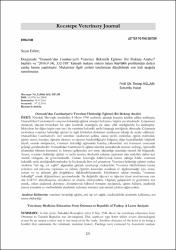| dc.contributor.author | Aslan, Recep | |
| dc.date.accessioned | 2019-01-25T06:03:29Z | |
| dc.date.available | 2019-01-25T06:03:29Z | |
| dc.date.issued | 2017 | |
| dc.identifier.citation | ASLAN, R. (2016). Osmanlı dan Cumhuriyet e Veteriner Hekimlik Eğitimi Bir Mektup Analizi. Kocatepe Veterinary Journal, 9(4), 332–338. | en_US |
| dc.identifier.uri | http://dergipark.gov.tr/download/article-file/386530 | |
| dc.identifier.uri | http://hdl.handle.net/11630/5242 | |
| dc.description | In this study, Nikolaki Mavroğlu's letter 8 May 1946 about the veterinary education from
Ottoman to Turkish Republic was investigated. This yearbook type letter which covers chronological
events by an output control way is our material in the study. Another character of the letter is its being a
booklet that summaries the veterinary medicine history. Findings were evaluated by document analysis
122
method. The findings in the letter regarding civilian veterinary medicine education such as foundation of schools, locations, training curricula, duration of education, academicians, teaching staff and students mobility largely coincides with the information of the other sources. It is seen that the original format of veterinary education is maintaining today but developed and updated. The letter which reflects the educational stages from Ottoman to Turkish Republic indicates that taking notes on events of the educational and occupational life and carrying out multidisciplinary scientific projects on education history are necessary to improve corporate culture in veterinary medicine. This is the first result to draw a conclusion from this historic letter by a bacteriology expert in veterinary medicine. However, "one medicine, one health" perception is weakened. Due to the insufficient perception of training veterinary surgeons mission, faculty of veterinary medicine is associated with the disciplines such as agriculture, forestry and fisheries. Therefore, the name of the faculty should necessarily be updated as Faculty of Veterinary Medicine. This will positively influence the EAEVE accreditation process. Scientific recording of events and observations will provide significant contribution for educational culture, academic time management and sustainable academic development. | en_US |
| dc.description.abstract | Nikolaki Mavroğlu tarafından 8 Mayıs 1946 tarihinde çalıştığı kuruma takdim edilen mektupta,
Osmanlı'dan Cumhuriyet'e veteriner hekimliği eğitimi süreçleri hakkında bilgiler yer almaktadır. Çalışmanın
materyali, olayları kronolojik bir çıktı kontrolü mantığıyla ele alan, yıllık niteliğindeki bu mektuptur.
Mektubun bir diğer özgün yanı özet bir veteriner hekimlik tarihi kitapçığı niteliğinde olmasıdır. Çalışmada
mektubun veteriner hekimliği eğitimi ile ilgili bölümleri doküman incelemesi tekniği ile analiz edilmiştir.
Osmanlı'dan Cumhuriyet'e sivil veteriner okullarının açılma süreci; tarihi, mekânlar, eğitim müfredatı,
eğitim süresi, hocaları, öğretim elemanı ve öğrenci hareketliliği gibi bulgular, diğer kaynaklardaki bilgilerle
büyük oranda örtüşmekte, veteriner hekimliği eğitiminin kuruluş yıllarındaki asıl formatını koruyarak
geliştiği görülmektedir. Osmanlı'dan Cumhuriyet'e eğitim sürecini aşamalarıyla aktaran mektup, öğrencilik
yıllarından itibaren kurumsal ve bireysel gelişmeleri not etme alışkanlığı açısından önemli bir belgesidir.
Ayrıca, veteriner hekimliği eğitimi ve tarihi üzerine akademik çalışma yapmanın tüm anabilim dalları için
önemli olduğunu da göstermektedir. Uzman Mavroğlu bakteriyoloji hocası olduğu halde, veteriner
hekimlik tarihi niteliğindeki mektubu ile bu konuda bize yol gösteriyor. Veteriner hekimliği eğitimi verilen
okulların "tek tıp, tek sağlık" algısından giderek uzaklaştığı söylenebilir. Veteriner fakültelerinin hekim
yetiştiren asıl misyonu toplumda ve yüksek öğretim kurumları nezdinde iyi algılanamadığı için, ziraat,
orman ve su ürünleri gibi disiplinlerle ilişkilendirilmektedir. Fakültelerin adının mutlaka "veteriner
hekimliği" olarak değiştirilmesi gerekmektedir. Bu değişiklik öğrenci ve öğretim üyesi motivasyonu yanı
sıra EAEVE akreditasyonu süreçlerini de olumlu etkileyecektir. Olguları, gelişmeleri ve gözlemleri not
etmek, onları akademik aktiviteye dönüştürerek bilimsel formatta paylaşmak, eğitim kültürü, akademik
zaman yönetimi ve sürdürülebilir akademik kalkınma süreçleri için önemli çıktılar sağlayacaktır. | en_US |
| dc.language.iso | tur | en_US |
| dc.identifier.doi | 10.5578/kvj.39341 | en_US |
| dc.rights | info:eu-repo/semantics/openAccess | en_US |
| dc.subject | Veteriner Hekimliği Eğitimi | en_US |
| dc.subject | Tek Tıp Tek Sağlık | en_US |
| dc.subject | Sürdürülebilir Akademik Kalkınma | en_US |
| dc.subject | Not Tutma Alışkanlığı | en_US |
| dc.title | Osmanlı'dan Cumhuriyet'e veteriner hekimliği eğitimi: Bir mektup analizi | en_US |
| dc.title.alternative | Veterinary medicine education from Ottoman to Republic of Turkey: A letter analysis | en_US |
| dc.type | article | en_US |
| dc.relation.journal | Kocatepe Veteriner Dergisi | en_US |
| dc.department | Afyon Kocatepe Üniversitesi | en_US |
| dc.identifier.volume | 10 | en_US |
| dc.identifier.startpage | 121 | en_US |
| dc.identifier.endpage | 128 | en_US |
| dc.identifier.issue | 2 | en_US |
| dc.relation.publicationcategory | Makale - Ulusal Hakemli Dergi - Kurum Yayını | en_US |



















